Disclaimer
The Dover Public Library website offers public access to a wide range of information, including historical materials that are products of their particular times, and may contain values, language or stereotypes that would now be deemed insensitive, inappropriate or factually inaccurate. However, these records reflect the shared attitudes and values of the community from which they were collected and thus constitute an important social record.
The materials contained in the collection do not represent the opinions of the City of Dover, or the Dover Public Library.
A History of Fires in Dover
June 28, 1689
Major Richard Waldron’s Garrison, Richard Otis Garrison, Payne’s Garrison, a half a dozen other houses, and Waldron’s mills at Cocheco Falls by all burned during an Indian attack known as the Cochecho Massacre.
April 17, 1847
There was a fire in the calico printery at Bellamy at 3:00 on Saturday afternoon. It caught in the dry house, and being so far out of town the building was doomed before help arrived. It was owned by Benjamin Poor, and run by Weeden and Henshaw. The loss was $4000 to $5000, insured, The Dover Gazette of the following week stated that engine, water wheel, and much of the contents were saved, but it is not clear how such permanent fixtures could be rescued.
December 27, 1847
Midnight, on a very cold night, a local conflagration occurred in a row of wooden stores north of the American House. It started in the building occupied by E.O. Laughton, auction and commission merchant, and spread to the adjoining building occupied by J.B. Saunders, confectioner, and a building of the heirs of the late Judge Durrell, occupied by Uriah Wiggin as a provision store, James Dion, barber, George W. Hayes, trunk and harness store, and shoemaker’s shop above. The night was still and by great effort the American House, owned and kept by Captain William B. Smith, was saved without harm, though only a few feet away. The loss is stated to have been $6000, very small for so extensive a fire, and the cause was unknown.
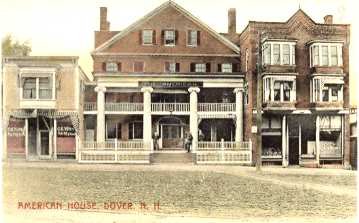
April 15, 1848
The freight station of the Boston & Maine was destroyed with nearly all its contents, only a few years after the railroad was built. The fire occurred at about 4 A.M. On Wednesday, April 5, 1848. The way bills were burned, but the loss was estimated to approximate $40,000. The liability of common carriers, it seems, was not then established, and the loss fell upon the owners of the merchandise. The Cocheco Manufacturing Company lost several cases of goods, C.C.P. Moses, a paper manufacturer in Dover, about $250 worth of paper, D.K. Webster some $800 worth of leather, and a heavy loss is said to have been sustained by Mr. James Littlefield. The fire is supposed to have originated in a pile of woolen waste belonging to the Norway Plains Manufacturing Company.
January 11,1850
At 10P.M. on Friday, January 11, 1850, there was a fire in the store of H.S. Plumer & Company, in the Cocheco Block. The fire-fighters had assistance from the Cocheco Manufacturing Company, and succeeded in confining the fire to the store in which it originated, but the stock, save for a small amount which was removed, was ruined, with at a loss of about $9000, insured in the Cocheco Mutual of Dover for $3500, and the Atlantic Company of Exeter for $1500. Plumer & Company lost their books of account and it was also at first thought a large sum in money. In the same issue of the Gazette which chronicled the fire, there is published a letter from a writer calling himself “Philo”, commending the partners as highly worthy young men who had met with a great business calamity and urging a public assistance to re-establish them.
The cause was supposed to have been the falling of a pile of cotton goods onto a stove. The damage to the building was between $1500 and $200, and a very wet night retarded the progress of the fire.
April 23, 1852
The paper-hanging factory of Crawford and Busby on Fifth Street caught fire at 2A.M. The factory and another building were wholly destroyed, and the dwelling of Busby damaged; loss $4500. Some one saw light in the factory an hour before the fire, and it was thought to have been incendiary (arson). A previous rain saved other buildings, but rendered the streets in bad condition for fire engines.
May 31, 1860
The large barn and several sheds belonging to James Littlefield burned. The buildings were filled with rags brought in by his peddlers. His house and store were saved.
September 19, 1860
There was an extensive conflagration at noon on the Landing. It consumed the storehouse occupied by George D. Vittum & Company, owned by John Trickey, containing 700 barrels of flour, 1000 bags of salt, and other property. Another nearby building, known as the Tannery, occupied by Stevens & Weed, in which the fire started, was badly damaged. The loss in the two buildings amounted to several thousand dollars, and, after being subdued, again broke out in the evening.
January 6, 1862
Fire broke out in the wooden stores on Central Street, near Orchard Street, known as Marston’s block. The fire originated in the D.N. Wendell Trunk and Harness shop, most likely from a stove. The weather was extremely cold, near zero, and several of the hand engines froze after a short time in operation. Tenants in the building had to be evacuated. They included Levi Brown’s shoe store, a dentist, Dr. P.A. Stackpole, tailor and merchant Alexander Frazier, R. Palmers shoe shop, D. Lothrop & Co. druggists, Miss E.A. Horne, dressmaker, Mrs. Shepard’s Boarding house, and Dr. Lindsey, amongst others. Frank Freeman’s oyster house was the only one left in condition to be occupied.
Marston's Block
August 9,
Daniel K. Webster’s barn burned along with its contents; 20 tons of hay and $700 worth of hides were consumed by fire caused by children playing with matches. The barn stood at the foot of Gage Hill and burned while the Websters were at church. Fortunately the nearby tannery did not catch fire.
November 30, 1865
Fire destroyed the oil carpet factory of Abraham Folsom & Son on Belknap Street. Seven buildings in the complex were completely destroyed, and three others were damaged. Fire broke out in the burlap painting building and was thought to be caused by spontaneous combustion. The works were in full operation with some 70 employees, and $6,000 worth of stock which had arrived the day before. Many of the workmen had just been transferred from the Biddeford plant which had burned down the month previously. The fire department battled valiantly using their new steam engines but due to the combustible nature of the materials, oil, benzene etc, the building could not be saved. The firemen had their work cut out for them just trying to prevent it from spreading to other streets.
November 23, 1866
The first Dover City Hall burned. It was built in 1842. In the early morning, the Hibernians were still holding a ball in the old City Hall on Central Square. About 1A.M. fire was discovered in the roof and about that time there was a considerable explosion. The firemen, upon seeing their response, had difficulty in getting at the fire, as it was contained by the slate roof, and were forced to carry their lines up on the inside. Nevertheless, they succeeded in stopping the fire after it had burned the roof and upper story. The upper story, which the Hibernians were using that night, was occupied by the Strafford Guards and the Light Battery for armory purposes, and the city offices were below. Though the lower part was drenched with water, no records were destroyed. The cause of the fire, or the early explosion, were never known, as 800 rounds of ammunitions, belonging to the Guards, was afterward found, having fallen to the lower story without exploding.
September 10, 1869
Fire at the Landing destroyed a storehouse and merchandise at Young’s Tannery.
November 1, 1870
A fire which started in the shoe shop of John E. Goodwin on Fourth Street destroyed several buildings in the area, including St. Aloysius Church. The church had just been moved to the lot so a new church could be built on Chestnut Street. The tower and walls of the church were left standing although they were damaged by fire and water. An eyewitness described the fire in the church edifice as one of solemn grandeur, the tower serving as a chimney and the great windows furnishing the draft, and says that the noise and rush of the fire and smoke through the tower were fearful to behold. Huge burning embers were carried away over the city by a howling gale, setting fire to thirty roofs, one being more than half a mile away. A Chapel Street resident was astride the ridgepole of his home quenching the landing sparks with a bucket of water and a dipper. A passerby, seeing the back of the coast of the amateur fireman had taken fire, is said to have shouted to him a warning in the flippant expression: “Better throw some water on your back; your coat is blazing.” Over $70,000 worth of property was destroyed by this fire. Benjamin Pray lost a three story building and a small shop, as well as a carpenters shop and lumber. Daniel Ford’s bottling plant was damaged too. C.E. Hayes and S. C. Hayes lost a stable and shop but their shoe shop and house were saved. They thanked the fire department by throwing them and oyster supper the next night.
January 30, 1871
Richard Rothwell’s machine shop at the Landing caught fire at 2 A.M. It was a total loss of $3,000.
July 1,1873
The Wiggin & Stevens Sandpaper mill on Gulf Road burned down. The fire was discovered at 1A.M. by the engineer on hand. It originated in the quartz crushing room, and was supposed to have been spontaneous, or incendiary. The building was 120 by 30 feet, three stories high, and the loss was $40,000 to $50,000, with $35,000 insurance. The firm employed about 30 hands.
December 28, 1878
Fire was discovered in the singeing room of the Cocheco Print Works. Fireman soon had it confined to the singeing room, steaming room, and bleachery. The ringing of the alarm was mistaken by some for the early sounding of the factory bell and caused some delay in calling the firemen. The firemen were hindered by extremely bad weather which caused the fire hoses and ladders to be encased in ice. Several firemen were injured. Captain Abbott to see a surgeon for stitches before he could return to the fire and assume command.
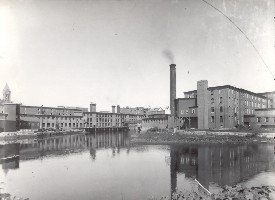
Cocheco Print Works
January 7, 1881
A fire at the Poor House at the Strafford County Farm killed thirteen people. The almshouse caught fire due to an overheated furnace and burned to the ground.
November 11, 1881
The large shoe shop owned by Ira W. Nute on Fourth Street was entirely consumed by fire. It was occupied by Burt and Strong and Charles A. Dow in the manufacture of shoes. The shop was filled with valuable machinery and stock. The fire company was crippled by lack of water. The fire swept across to Fifth Street. On Fourth Street the double tenement house of Joshua Bragdon and a carpenter shop west of it owned by Edward Blaisdell and the house of F.W. Tibbetts were consumed and on Fifth Street the houses of John Leighton, Ira W. Nute and Edward Morrill with five stables and the barn of the Misses Hill. The houses of George B. Wentworth and Charles Morrill were damaged. One of the members of the Northam Colonists who was taken to this fire was so anxious not to miss anything that her clothing caught fire three times and the feathers were burned off her hat.
December 29, 1881
A fire in Thurston’s shoe shop near the depot broke out in a store recently vacated by Wakefield and Colbath. It spread to the store of C.F. Cole whose entire stock of boots and shoes were lost. The grocery store of John H. Grimes was totally destroyed. In this fire there was not sufficient force to the water to reach the fire. The firemen took great risks carrying the hoses up the ladders when burning timbers were constantly falling about them.
May 2, 1882
A fire broke out at7:40 A.M. in the brush factory operated by Lewis B. Laskey on Washington Street. The factory was 50 feet back from the street and in the rear of the Washington Street Free Will Baptist Church. A breeze blew the flames toward Fayette Street and very quickly a two story dwelling in the rear took fire, also a barn in the rear of the brush factory. At the same moment flames were seen issuing from the eaves of the church. The firemen were implored to train the streams on the church but owing to confusion of orders this was not immediately done and the fire spread to the roof which was almost instantly ablaze. The whole upper story of the structure including the tower was one unbroken sheet of flame burning with increased fury, and soon was heard the crash and boom of the upper floor as it fell to the one underneath with a terrific report. The blazing frame of the tower finally tottered over into the flames which filled the interior of the church.
This church was built in 1870 at a cost of $23,000 and the last installment on the church debt had been paid, and about a month before the fire, the mortgage was burned with great rejoicing.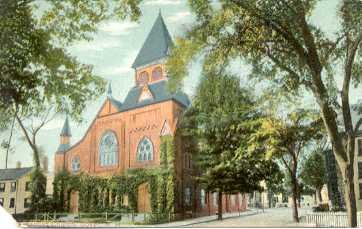
The high wind of Tuesday afternoon blew over the gable end and both chimneys of the church which had been left standing. There were several persons in the vestries looking over the ruins some of whom, Mrs. Stuart Clifford, Mrs. Jed Whitney, Job N. Burley and a boy by the name of Dominegue were injured. They were with difficulty taken from the ruins. All were supposed to have been removed. As John R. Varney did not come home to tea his daughter cam down town to learn the cause. He could not be found. On inquiry it was learned that he had been seen in the church at the time of the crash. Search among the ruins was at once instituted by Mayor Murphy and at 11o’clock the body was found. It was evident he must have died instantly being hit by a falling timber which lay lengthwise over his body. The grief over Mr. Varney’s death was as deep as it was universal and the whole city wore an air of sadness. At his funeral in the First Parish Church the edifice was filled. Members of the school board, the City Government, members of the bar and the police force attended in a body.
October 29, 1882
On Sunday morning at 1 a.m. fire was discovered in the steam mill of W.P. Hayes on Union Street. General alarm was given by ringing of bells and the gong on the engine house. The fire department was well managed by Major Abbott. The L and about 100 feet of the main part was burned and the rest was damaged. At this mill was manufactured doors, windows and blinds. It was supposed to have caught from the chimney. Loss $35,000. In 1845 this mill, then owned by James H. Davis, was burned to the ground.
April 15, 1887
Cocheco Print Works
On April 15, 1887 occurred one of the most disastrous fires that had visited the city for many years. A peculiar feature of the fire was the rapidity with which it spread. Many workmen had barely time to escape, not a few dropping through the scuttle rather than risk the stairs. J.T. Sawyer the engineer was at work about the engine when fire burst into the room. He stopped the engine and leaped out through a window. Clothes containing wallets and other valuable were left behind to perish in the flames. The flames shot from the windows and streamed through the roof in such a raging manner that it seemed no human power could quench them. In the basement were stored drugs, chemicals, oils, etc. On the first floor the printing room was in charge of Benjamin Brierly. In this room were the 12 printing machines valued at $8,000. They went down with the burning floor a mass of twisted iron. Sixty workmen were employed in the burned part. There were 500 in the whole building. Washington Anderton was at that time superintendent, Howard Stockton treasurer. Two hundred thousand yards of print were burned or damaged. The fire originated in the mather cloth drying box and was so situated that it was impossible to get at it before it had spread extensively. Fortunately no one was killed. The part burned had been standing 30 or 40 years. A heavy explosion heard in the afternoon was caused by fire coming in contact with 1000 pounds of chlorate of potash. On account of the great quantity of explosives in the basement it was one of the most alarming fires. The next morning a designer from Boston was drawing up plans for a new building.
March 22, 1889
The second Dover City Hall burned down.
From the Dover Enquirer, “the City Hall of Dover upon which so much money has been expended, with which so much fault has been found, the City Opera House which despite its small size has been the pride of the city is now but a blackened mass of smoldering ruins and shaky brick walls. With new water works, a fire department always considered efficient, everyone wonders how a fire which was so insignificant at the start should spread beyond all control and destroy the property of the county and the town.” Police officer Robinson discovered a blaze near the furnace. The alarm was rung in and then the tramps let out of the police station. The stream from the hydrant was put on and everyone thought the fire had been smothered. Suddenly a stream of fire was seen in the court room and from there it extended to the stage and dressing rooms and the city hall was doomed. Twenty streams were soon playing on the fire, several of them misdirected. George E. Durgin, Clerk of Court, arrived none too soon to secure is property in the office. He saved his furniture and a strong box containing documents of great value. John B. Stevens, city Clerk, braved the smoke in his office and succeeded in saving a large amount of property with the help of officers and firemen. Frank Thompkins, Register of Deeds, managed to clear his office of most of the valuables. C.S. Clifford, Register of Probate, saved part of his office furniture and papers of value. The Belknap Church as usual took fire but was saved by the Cocheco Mfg. Co. Hose. When the dome of the City Hall was all on fire and just before it fell it looked like a gigantic piece of fire works. The clock kept right on going and not until the fire had half consumed the tower did it cease running. It stopped at 3:30. When the roof of the tower gave way the heavy clock crashed down through the stairways and woodwork stirring up the fire and making it burn more furiously. (Many people though the building might have been saved under good management of the fire department. After the fire got beyond control the streams were directed to the safe in City Clerk Stevens office to save the records. The last official work done in this office was the reading of the final proofs of the reports of the City Government for 1888. The readers are now among the Northam Colonists. When the vaults in the buildings were opened the contents were found injured by water but not destroyed. The High School cadets lost half their guns in the conflagration. A few evening before the fire, a dramatic entertainment, the play of Ben Hur, was given by local talent, under the auspices of ladies interested in the establishment of a Home for the Aged in this city, and on the night of the fire a crowded house listened to a concert by a Swedish quartette. On both of these occasions questions as to the safety of the hall, especially the balconies were raised so the citizens consoled themselves for their loss in thinking that possibly a greater catastrophe had been averted.
March 9, 1890
The Sawyer School on Fifth Street, built in 1870, was destroyed by fire. A new Sawyer School was built on the same site. On Sunday morning, March 9, 1890 the roof of the Sawyer School building was burned off and also the school rooms in the second story near the center. The first floor was damaged only by water.
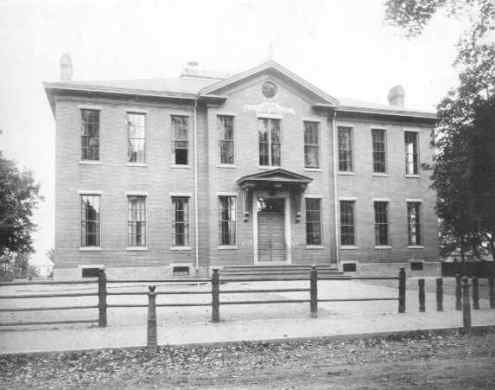 Sawyer School
Sawyer School
The fire was supposed to have caught from the furnace which was thought was not properly looked after by Emerson the janitor. The committee on repair of school houses recommended that a Mansard roof be put on when the school house was rebuilt, and a hall for exhibition and drill be added, with a seating capacity for 400, and it was so recommended by the school committee at the next meeting. This was not done however as the frame work was not considered sufficiently strong to support another story. The pupils were sent to School Street, to Ward house Fifth Street, Hook and Ladder house, First Street and Lowells hall.
March9, 1893
Fire broke out at the County Farm Asylum while inmates were locked in their rooms, 41 of them died.
June 17, 1897
As church-goers were returning to their homes on Sunday, they witnessed a spectacular blaze. This was the burning of the wooden observatory on Garrison Hill. The records of the fire department show they were called out by an alarm from the box at Central Avenue and Abbott Street at 1:08 P.M., but the inaccessibility of the structure rendered their efforts valueless and it was wholly consumed. The hill remained without an observation tower from that time until the city established Garrison Hill Park and Sawyer Memorial Tower was erected in 1913.
March 29, 1906
The fire in the Masonic Temple was discovered by Officer Stevens. He gave the alarm and rushed into the building shouting to those who roomed there of their danger. The inmates escaped, being unable to save personal effects and barely their lives. The case of Miss Peaslee was the most sensational. After all were supposed to be out it was discovered that Miss Peaslee was in the burning building. Lieutenant Jones and Charles Clark of the Hook and Ladder Company went up a ladder and affected a rescue. On reaching the ground Miss Peaslee was much cooler that the majority of people who had been watching her. All the steamers and all the hose of the Fire Company, Cocheco Manufacturing Company and I.B. Williams and Sons were in use. Portsmouth Fire Company came but did not unload their engines. During the fire it looked as if the buildings in close connection to the Temple were doomed. The night was a tedious one for the firemen who suffered much from cold after being drenched to the skin, but they kept faithfully at work going from place to place extinguishing the numerous blazes that were caused by flying embers. The building stood on the site of the old city hall which was destroyed March 33, 1899. The Temple building was given to Mack and Co. of Salem for 80,900 on June 1, 1891.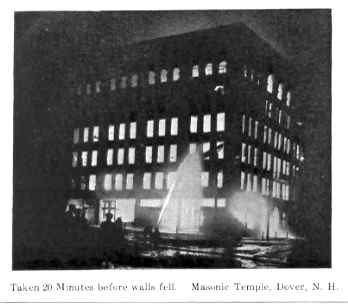
January 26, 1907
Mill #1 of the Cocheco Manufacturing Company was nearly destroyed by fire January 26, 1907. The alarm was given at 6:33 in Saturday morning for a fire which broke out in the middle of the fourth story of the building. Some of the operatives in the fourth and fifth stories were cut off by smoke from the stair ways and there was only one fire escape in the back side of the mill. They became panic stricken. Two jumped from the fourth story window and were seriously injured—a dozen men slid down a rope which had been made fast inside a window burning and lacerating their hands in a horrible manner by the friction and some found their way to the fire escape. All those who were injured were as quickly as possible sent to the Wentworth hospital.
Streams of water were played from the engines on Washington Street but the pressure of the water service was very poor and very little water reached the flames. Assistance was given by the Portsmouth Fire Company, The Cocheco Company and Williams Belt factory. The automatic sprinklers in all the stories save the fourth worked perfectly and this with the fire doors no doubt was the means which prevented the spread of the flames in the lower part of the mill.
After the fire had been burning 3/4s hour four men were discovered with their heads outside of a window in the fifth story on the back side calling for rescue. The firemen at once put up ladders which lacked 20 feet of reaching the window. An extension ladder was added and still there was a lack of 10 feet. Lieutenant Bradley of House 1 volunteered to take a pole up and lash it to the top of the ladder. The other end was lashed to the window sill by the men. Bradley stood at the top of the ladder and received the men as they slid down the pole. He did a most daring and heroic piece of work in rescuing them. No. 1 mill was erected by the Cocheco MFG. Company in 1877 at a cost of 640, 000. Five Hundred hands were employed. The machinery cost upwards of a million dollars. The machinery on three upper floors was ruined while that on the first and second was damaged only by water.
This fire showed the need of additional fire apparatus. Soon after 2000 feet of hose and a fire net were purchased, with other appliances, to insure greater safety to the firemen, and to facilitate the discharge of their duties. Mayor White in his last inaugural said the exhibition of bravery by the firemen that day stamped them as real heroes and won for them the lasting gratitude of our citizens.
November 8, 1907
The main part of the American House on Franklin Square was badly burned out Thursday morning, November 8, 1907. The proprietors, their families and guests had narrow escapes from suffocation by the dense smoke which filled every room in the house before the fire was discovered between the partitions and the seat of it could not be reached. The smoke was so dense that the firemen were unable to get into the cellar to shut off the gas and this escaping only added fuel to the flames and kept them spreading to other sections of the house. The fire was discovered by Patrick Shea, the clerk, who with the proprietors went to the rooms of the guests to warn them of the danger. Many escaped thinly clad leaving valuable articles in their rooms. The private apartments of the proprietors with the stores underneath in the two wings received very little damage. The stable managed by John L. Foss was uninjured. The citizens who were at the fire rendered all possible service in furnishing clothing and shelter to guests. The fire caught in the basement. When the fire had been subdued Chief Varney assisted the guests in recovering their property.
January 30, 1913
Central Hall, located on Central Avenue was gutted by a fire which started in an oven. The building housed Townsend’s Bakery and Harry Grover’s car dealership. Twenty one cars had to be moved from the burning building. No caught fire but they were damaged by water.
October 6, 1916
Fire destroyed the Franklin Square Garage. Seventeen cars inside the garage were badly damaged.
January 6, 1918
Fire destroys the Wiggin Block on Central Avenue.
October 18, 1927
The club house at the Cochecho Country Club burned down.
January 3, 1932
Fire destroyed both Morrill blocks in Franklin Square. Twenty six businesses were destroyed. The blaze required fireman from as far away as Haverhill, Massachusetts, and burned so hotly that the sprinkler system in the Strand Theater was set off The Morrill Block was rebuilt on a smaller scale. The new building had only two floors and ran from Third Street to Second Street. No cause was discovered for the fire.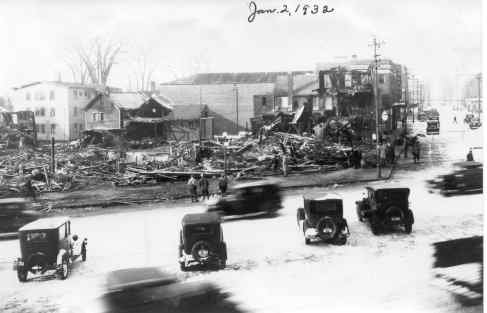
August 3, 1933
The third City Hall burned. The City Hall and Opera house was dedicated December 16, 1891 and cost $250,00 to build. It featured a floor that could rise and fall, a chandelier with 95 electric bulbs, three tiers of boxes with brass rails, velvet curtains with gold fringe, a frescoed ceiling and a cupid mural. The Opera House had a seating capacity of 1800 and was the largest stage in New Hampshire. Luminaries such as Jason Robards, Alfred Lunt, Shirley Booth and John Philip Sousa’s band graced the stage. The first full length movie shown here was “Birth of a Nation” starring Lillian Gish.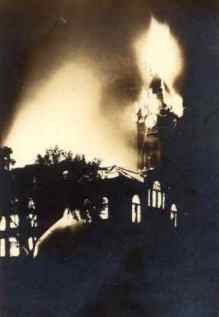
1935 Broadway Baptist Church/ Clement Theater burned.
July 16, 1939
Fire destroyed the 48 year old coal shed of York Coal and Lumber Company of Burnham and Demerritt Court. The fire also gutted six tenement buildings and left 90 people homeless.
January 9, 1944
Fire at the garage of the Wentworth Bus company at the corner of Milk and Mt. Vernon Streets destroyed four busses and a taxi.
April 27, 1950
Robbins Auto Supply had a devastating fire in its store on Washington Street, in the old Orpheum Hotel building. Robbins Auto Parts opened up again the next day in another part of the store that hadn’t been damaged by fire. The store was rebuilt and is still operating today.
December 9, 1952
Guppy House, which was built in1690, was gutted by fire. The fire was caused by faulty construction of the old heating system.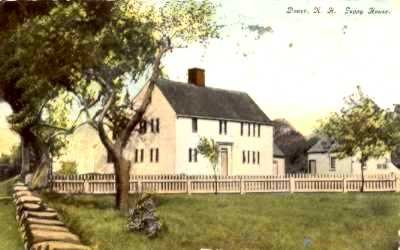
December 1956
The Greek Orthodox Church was burned to the ground. Church members raised $38,000 and a new building went up in 1958.
October 25, 1956
Siegel’s Department Store burned to the ground despite the efforts of almost 70 firemen from 7 surrounding communities. One fireman was overcome by smoke, four others narrowly averted disaster when they leaped from the roof of the burning building seconds before it burst into flames and collapsed. Traffic on Central Avenue was jammed up for two miles and all telephone communications between Rochester, Somersworth and North Berwick were destroyed by the fire. The blaze was so hot that 400 feet of hose filled with water burned as fireman watched. Huge crowds were driven back as roaring flames leapt from the building and windows shattered. Paint cans and ammunition exploded at the rear of the building. Firefighters worked for nine hours to bring the fire under control.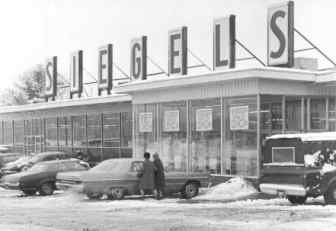
September 30, 1981
The County Farm Bridge, the last covered bridge in Strafford County, was destroyed by fire. The bridge was built around 1870 and had an unusual construction featuring a Howard Truss; a rigid wood and iron span. It was also unique for flat pitch of the bridge’s roof. The fire department ruled the fire was suspicious in origin. Firefighters from Dover and Barrington fought the fire for over an hour before the bridge collapsed into the Cocheco River.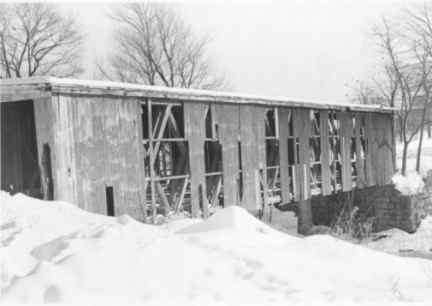
May 1983
More than 50 firefighters from five communities fought the massive blaze that destroyed Newick’s Restaurant. The fire began in the gift shop at the front of the building and was ruled accidental. The buildings wood frame and large open spaces contributed to the seriousness of the fire which took over 3 ½ hours to bring under control. When firefighters broke through the front door the fire flashed over them, knocking two men to the ground. Cylinders of carbon dioxide used to ventilate the lobster tanks exploded intermittently but there were no injuries. Newick’s Restaurant was quickly rebuilt and back in business.
February 18, 1989
St. Mary Parish Hall, located on Chestnut Street, was gutted by fire caused by careless disposal of smoking materials. Nearly 60 firefighters from 5 surrounding communities battled the fire which began about 2 hours after a Bingo game ended.
Resources include the Dover Public Library Dover fires file.
Mrs. John Scales paper entitled The Great Fires of Dover, c. 1908 from the Northam Colonists files.
Notable Fires in Dover by Charles Wesley Thompson, c. 1919 from the Northam Colonists files.
This historical essay is provided free to all readers as an educational service. It may not be reproduced on any website, list, bulletin board, or in print without the permission of the Dover Public Library. Links to the Dover Public Library homepage or a specific article's URL are permissible.
